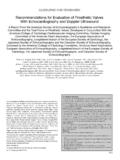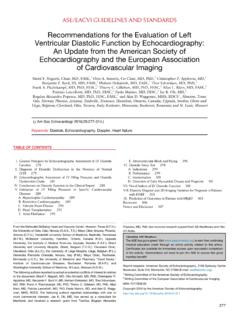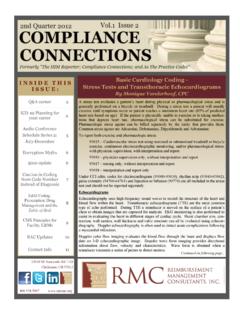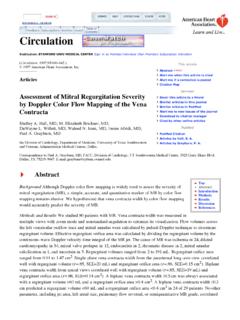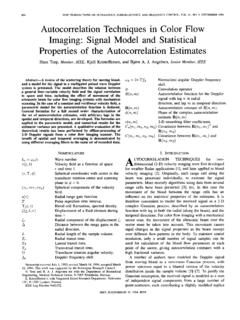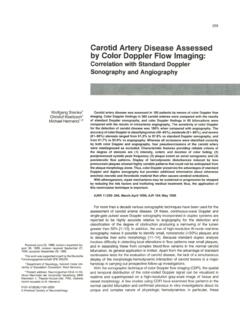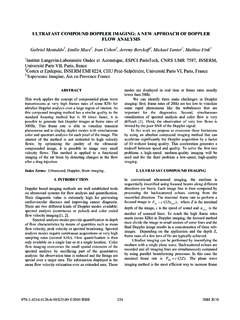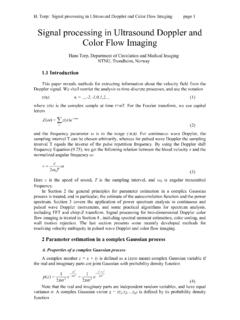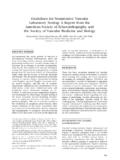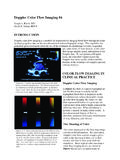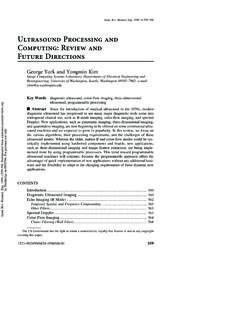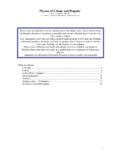Transcription of Recommendations for Quantification of Doppler ...
1 167 INTRODUCTIOND oppler echocardiography is a noninvasive tech-nique that provides unique hemodynamic informa-tion otherwise not available without invasive accuracy of the results depends, however,on meticulous technique and an understanding ofDoppler principles and flow dynamics. This docu-ment provides Recommendations based on the sci-entific literature and a consensus from a body ofexperts to guide the recording and measurement ofDoppler document is not a comprehensivereview of all the clinical applications of PRINCIPLESThe Doppler principle states that the frequency ofreflected ultrasound is altered by a moving target,such as red blood magnitude of thisDoppler shift relates to the velocity of the bloodcells.
2 Whereas the polarity of the shift reflects thedirection of blood flow toward (positive) or away(negative) from the transducer. The Doppler equa-tion F = V 2 Foc cos (1)states that the Doppler shift ( F) is directly propor-tional to the velocity (V) of the moving target (ie,blood cells), the transducer frequency (Fo), and thecosine of the angle of incidence ( ) and is inverselyproportional to the velocity of sound in tissue (c =1540 m/s). The Doppler equation can be solved forblood flow velocity as follows:V = 2F oF cocs (2)When solving the Doppler equation, an angle of inci-dence of 0 or 180 degrees (cosine = ) is assumedfor cardiac , Doppler echocardiography consists of 3modalities: pulsed wave (PW) Doppler , continuouswave (CW) Doppler , and color Doppler imaging .
3 PWDoppler measures flow velocity within a specificsite (or sample volume) but is limited by the aliasingphenomenon that prevents it from measuring veloc-ities beyond a given threshold (called the Nyquistlimit). CW Doppler , on the other hand, can recordvery high blood flow velocities but cannot localizethe site of origin of these velocities along the path-way of the sound beam. color flow Doppler usesPW Doppler technology but with the addition ofmultiple gates or regions of interest within the pathof the sound beam. In each of these regions, a flowvelocity estimate is superimposed on the 2-dimen-sional (2D) image with a color scale based on flowdirection, mean velocity, and sometimes echocardiography is used to evaluateblood flow velocity with red blood cells as the mov-ing target.
4 Current ultrasound systems can also applythe Doppler principle to assess velocity within car-diac tissue. The moving target in this case is tissue,such as myocardium, that has higher amplitude ofbackscatter ultrasound and a lower velocity com-pared with red blood cells. This new application isReprint requests: American Society of Echocardiography, 1500 Sunday Dr, Suite 102, Raleigh, NC 27607. J Am Soc Echocardiogr 2002;15:167-84 Copyright 2002 by the American Society of $ + 027/1/120202 for Quantificationof Doppler Echocardiography:A Report From the Doppler QuantificationTask Force of the Nomenclature andStandards Committee of theAmerican Society of EchocardiographyMiguel A.
5 Qui ones, MD, Chair, Catherine M. Otto, MD, Marcus Stoddard, MD,Alan Waggoner, MHS, RDMS, and William A. Zoghbi, MD, Raleigh, North CarolinaAMERICAN SOCIETY OF ECHOCARDIOGRAPHY REPORT called tissue Doppler and can be performed in thePW or the color mode. A comprehensive discussionof this new technology is beyond the scope of thisdocument; however, some of the newer applicationsfor measuring regional myocardial velocities that usethe PW mode will be echocardiography has 2 uses: detectionand quantitation of normal and disturbed flowvelocities. For detection purposes, all 3 modalitieshave high sensitivity and specificity.
6 However, colorflow Doppler often allows faster detection ofabnormal flows and provides a spatial display ofvelocities in a 2D plane. Quantification of flowvelocity is typically obtained with either PW or CWDoppler. Measuring velocity with color Doppler ispossible, but the methods are still under develop-ment and have not been standardized across differ-ent brands of ultrasound equipment. (One excep-tion is the proximal isovelocity surface accelerationmethod, used in the evaluation of valvular regurgita-tion.) The primary use of PW Doppler is to assessvelocities across normal valves or vessels to evaluatecardiac function or calculate flow.
7 Common appli-cations include measurements of cardiac output(CO) and regurgitant volumes, quantitation ofintracardiac shunts, and evaluation of diastolic Doppler , on the other hand, is used to measurehigh velocities across restrictive orifices, such asstenotic or regurgitant valve velocitiesare converted into pressure gradients by applyingthe simplified Bernoulli equation:pressure gradient = 4V2(3)This equation has been demonstrated to be accu-rate in flow models, animal studies, and in the car-diac catheterization laboratory as long as the velocityproximal to the obstruction does not exceed Common clinical applications include deter-mining pressure gradients in stenotic native valves,estimating pulmonary artery (PA) systolic pressurefrom the velocity of tricuspid regurgitation (TR), anddetermining prosthetic valve gradients.
8 The combi-nation of PW and CW Doppler has been used withgreat accuracy to determine stenotic valve areaswith the continuity alternative technique also used for recordinghigh flow velocities is the high pulse repetition fre-quency (PRF) modification of the PW Doppler . HighPRF uses range ambiguity to increase the maximumvelocity that can be detected with PW sample volumes are placed proximal toJournal of the American Society of Echocardiography168 Qui ones et alFebruary 2002and at the depth of interest. PRF is determined bythe depth of the most proximal sample volume,which allows measurement of higher velocitieswithout signal aliasing at the depth of the resulting spectral output includes fre-quencies from each of the sample volume depths,the origin of the high-velocity signal is inferredfrom other anatomic and physiologic data.
9 As withCW ON RECORDING ANDMEASUREMENT TECHNIQUESThe accuracy of measuring blood cell velocities byDoppler relies on maintaining a parallel orientationbetween the sound waves and blood most ultrasound systems allow correc-tion of the Doppler equation for the angle of inci-dence, this measurement is difficult to performaccurately because of the 3-dimensional orienta-tion of the blood flow. Angle correction is there-fore not recommended. The Doppler sound beamshould be oriented as parallel as possible to theflow, guided both by the 2D image (sometimesassisted by color flow imaging ) and the quality ofthe Doppler recording.
10 Small (<20 degrees) devia-tions in angle produce mild (<10%) errors in veloc-ity measurements. Although these errors may beacceptable for low-velocity flows , when Doppler isused to derive pressure gradients even a smallerror in velocity measurement can lead to signifi-cant underestimation of the gradient because ofthe quadratic relation between velocity and pres-sure DopplerPW Doppler is used in combination with the 2 Dimage to record flow velocities within discreteregions of the heart and great vessels. Measurementsderived from these velocities are used to evaluatecardiac performance (Figure 1).

